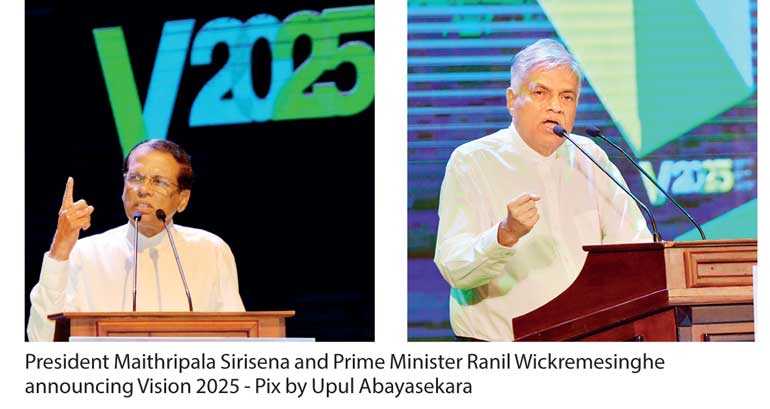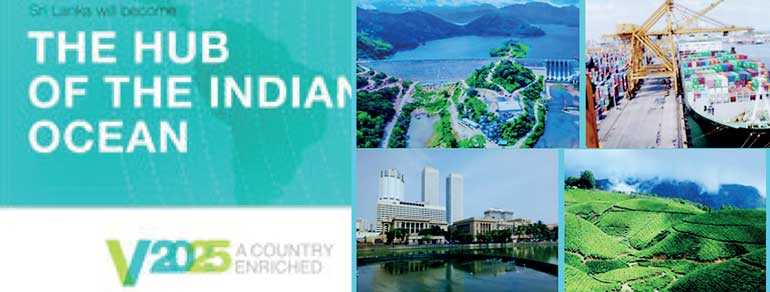Wednesday Feb 19, 2025
Wednesday Feb 19, 2025
Wednesday, 5 September 2018 00:00 - - {{hitsCtrl.values.hits}}

 By Srimal Fernando
By Srimal Fernando
and Mizly Nizar
Sri Lanka geopolitically positioned at an important inter section in the Indian Ocean is on a developmental approach to reinvigorate its socio-economic growth. The interconnectivity between India and Sri Lanka and the broad-based economic expansion policy plans of ‘New India 2022’ and ‘Vision 2025’ of Sri Lanka indicates the extent to which the two countries vie to continue with reforms to increase growth , jobs and wages.
Sri Lanka’s Vision 2025 is founded on a set of core principles including a strategy for national exports, social market economy and a skill pool to match the demands of the job market. Vision 2025 has fixed targets of achieving an annual export income of $ 20 billion, increase Foreign Direct Investment (FDI) up to $ 5 billion and to create employment opportunities for at least a million Sri Lankans by 2025.
This ambitious goal is however not without apprehension. The statistical figures in the recent past since the new government came into power in 2015 indicate a steady decline in annual Gross Domestic Product (GDP) growth rates. The 5% growth rate in 2015 has fallen to a low of 3.1% in 2017.
The looming elections which could cause market volatility closer to the polls and the sense of the existence of a shadow government appears to have lowered investor confidence. Hence a strong political leadership is cited as the defining factor for the success of this vision plan in the next few years. Furthermore, another important factor to boost investor confidence and enhance the economy is to have concrete measures for transparency and accountability in all processes in both the public and the private sector administrations.
It is commonly acknowledged that the key element to enterprise reforms in Sri Lanka is the development of the micro enterprise sector with the promotion of Small and Medium Enterprises (SMEs) which generate over 50% of GDP. Hence, subsidies for small agricultural holdings can be perhaps cited as one of most important factors that can drive the economic growth levels of SMEs while also facilitating the country to achieve required levels in food security.
Though the country has seen a decline in poverty over the years, income disparity remains one of the highest among Asian countries. The Poverty Head Count Index had dropped from 8.9 in 2009/10 to 4.1 in 2016. However, despite the rising income levels as reflected through per capita GDP estimates, income inequality remains high with the poorest 20% of the population accounting for only 4.8% of the income while the richest 20% have earned 50.8% of the total income. Hence, while initiating measures to boost economic growth, it is imperative to have processes in place to increase the share of national income available to the poor.
Foreign Direct Investments (FDIs) are important to boost the economy for small countries such as Sri Lanka. FDIs in the country have seen a steady increase from $ 680 million in 2015 to $ 1.4 billion in 2017. It is expected that the new Inland Revenue Act and the Foreign Exchange Act aimed at promoting the investment climate will help Sri Lanka achieve its target of $ 5 billion by 2025.
Over the past 10 years the nation’s development agenda has been based on state level interventions with borrowings from foreign nations at high interest rates. These loans put pressure on the country’s economy. Heavy borrowings from China and India come with their own strategic interests impinging on Sri Lanka’s development agenda.
The National Unity Government elected in 2015 began to advocate radical economic reforms by obtaining loans through the International Monetary Fund (IMF) to boost economic growth. One of the most widely adopted economic reform measures entail tax reforms to increase government revenue, as agreed with the IMF in exchange for a $1.5 billion, three-year loan.
The country’s export performance had recovered after the slump in the years 2015 and 2016 to $ 11.4 billion in 2017 slightly higher than the 2014 figure of $ 11.1 billion. Improvement in export income occurred through the restoration of the GSP + with effect from 19 May 2017 providing exports from Sri Lanka preferential market access on par with countries such as Bangladesh, Pakistan and several countries from Africa and South America.
The recent investment of $ 1.5 billion by China in the Colombo Port City project helped boost the country’s economy. Another important foreign exchange earner to the country is worker remittances amounting to $ 7.2 billion in 2017 from around 1.8 million Sri Lankans working abroad.
Although economic reforms as cited above have played a role in attempting to increase economic performance, there is still a long way to go in meeting the set targets in the Vision 2025 Sri Lanka policy report. Despite having measures in place to achieve these objectives, the most important transformation for Sri Lanka should be one that reflects sustainable economic growth that is inclusive while incorporating measures for multidimensional development in the socio, economic and political spheres.
[Srimal Fernando is Global Editor of Diplomatic Society for South Africa and a Research Scholar at Jindal School of International Affairs, India. Mizly Nizar is a Foreign Policy Analyst and a former Visiting Lecturer at the Bandaranaike Centre for International Studies (BCIS) and the Open University of Sri Lanka.]
Discover Kapruka, the leading online shopping platform in Sri Lanka, where you can conveniently send Gifts and Flowers to your loved ones for any event including Valentine ’s Day. Explore a wide range of popular Shopping Categories on Kapruka, including Toys, Groceries, Electronics, Birthday Cakes, Fruits, Chocolates, Flower Bouquets, Clothing, Watches, Lingerie, Gift Sets and Jewellery. Also if you’re interested in selling with Kapruka, Partner Central by Kapruka is the best solution to start with. Moreover, through Kapruka Global Shop, you can also enjoy the convenience of purchasing products from renowned platforms like Amazon and eBay and have them delivered to Sri Lanka.
Discover Kapruka, the leading online shopping platform in Sri Lanka, where you can conveniently send Gifts and Flowers to your loved ones for any event including Valentine ’s Day. Explore a wide range of popular Shopping Categories on Kapruka, including Toys, Groceries, Electronics, Birthday Cakes, Fruits, Chocolates, Flower Bouquets, Clothing, Watches, Lingerie, Gift Sets and Jewellery. Also if you’re interested in selling with Kapruka, Partner Central by Kapruka is the best solution to start with. Moreover, through Kapruka Global Shop, you can also enjoy the convenience of purchasing products from renowned platforms like Amazon and eBay and have them delivered to Sri Lanka.